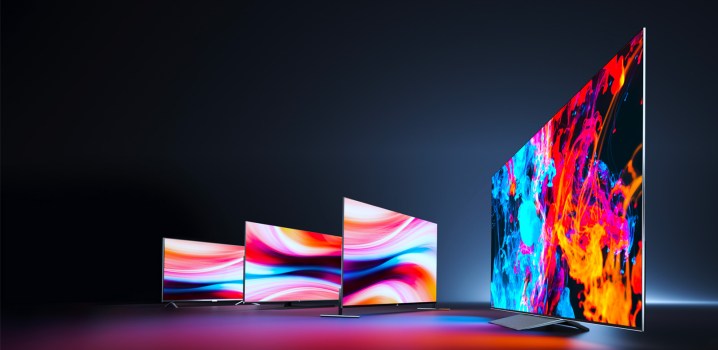
Even At A Virtual CES, TCL Is Taking Names And Kicking Ass
I’d like to take a moment, now that CES 2021 is heading into its final hours, to acknowledge TCL.
Ten years ago, I attended CES 2011. Among the enormous booths from TV titans like Sony, Panasonic, Samsung, and LG was a smaller booth from a brand I had never heard of. Yep, it was TCL. Looking around that booth and taking in the sights of the many TVs TCL was showing off, I had only one thought: Man, what bunch of junk.
What a difference a decade can make.
That sounds uncharitable, and I suppose it was, but context is everything. Back then, the major brands were showing off LCD TVs with very good black levels, contrast, and color, plasma TVs that were the pinnacle of picture quality, and 3D was just beginning to get a serious toehold. TCL’s TVs, by comparison, were small, boring-looking, and had poor black levels and contrast. They were also very cheap.
Well, what a difference a decade can make. One look at the TV landscape here at CES 2021, and it’s immediately apparent that TCL is continuing its rapid and unprecedented path to becoming the most important TV brand in the world.
Rapid rise
Well, perhaps it’s not entirely unprecedented. I’m reminded of Hyundai’s debut offering in Canada back in the early 1980s, a four-door hatchback called the Pony. Canadians snapped them up because, with a base price of $5,795, they were far cheaper than any other car at the time. Ten years later, you’d have been hard-pressed to find even one Pony still on the roads. They were poorly built, and not designed to withstand punishing Canadian winters. But as crappy as the Pony was, it gave Hyundai a much-needed presence in the North American market and the rest, as they say, is history.
TCL’s trajectory has been similar, but it has accomplished its evolution from bargain-basement to innovation leader in a fraction of the time it took Hyundai to emerge as a major force in its industry. The evidence abounds.
In 2014, TCL became one of the first TV makers to adopt the Roku software, thus creating its line of Roku TVs. The first smart TV models didn’t get a lot of praise for their picture quality, but there was wide agreement that the Roku TV platform was a game-changer for smart TV user experiences.
In 2016, TCL added 4K resolution to its Roku TV lineup, making it one of the most affordable ways to get a 4K TV. Again, its picture quality wasn’t much to brag about, but you couldn’t ignore that TCL was pushing into new TV territory at an accelerating pace.
One year later, in 2017, TCL created the P-Series, its first 4K Roku TV with HDR support. Bam! The P-Series stunned seasoned reviewers with its color and contrast, not so much because these TVs were better than the competition, but because they were just as good while costing hundreds of dollars less.
From that moment, TCL has been on a TV tech tear. Its 4-, 5-, and 6-Series became the value benchmark, eclipsing even Vizio, which had been the U.S. value leader. In 2019, it made a quantum leap (literally) when it introduced the 2019 8-Series, the company’s first quantum dot TV, which was also the first mini-LED TV ever sold, a full two years before mini-LED technology would make its way into competitors’ products.
TCL continues its push into territory that was once the exclusive domain of Sony, LG, and Samsung.
TCL used 2020 to double down on its mini-LED quantum dot display tech by adding both to the 6-Series — without increasing the price. Meanwhile, the less expensive 5-Series acquired quantum dots, making it one of the most affordable QLED TVs on the market. All three models, the 5-, 6-, and 8-Series, have earned high praise and strong reviews.
Still climbing
That brings us to CES 2021. This year, TCL continues its push into territory that was once the exclusive domain of Sony, LG, and Samsung. Its 6-Series will be gaining an 8K model, the company’s first 8K TV, and TCL is promising prices on these TVs that will continue the 6-Series’ reputation for extreme value.
It’s also committed to bringing its new OD-Zero mini-LED backlighting tech to market this year, which should produce the thinnest, and highest contrast, non-OLED TV to-date.
 Image used with permission by copyright holder
Image used with permission by copyright holder
Finally, TCL is on track to produce three new TV models at the gargantuan 85-inch screen size. TCL is calling these giants its “XL” models, and they’ll include a 4-Series 4K version (which will likely set new affordability records for this size), as well as an 8K model.
So what does the future have in store for TCL? In the short term, we still hope that it will debut its first TVs based on the Vidrian mini-LED technology it showed at CES 2020. In the longer term, there’s reason to believe that the brand will expand into bleeding-edge display technology like QD-OLED. As it does so, you can bet it will continue to work on its picture-processing hardware and software.
Will we eventually see TCL TVs that threaten the picture quality supremacy of Sony and LG? If that seems far-fetched, keep in mind, back in the ’80s, no one could have expected Hyundai to produce a car that rivals the top luxury sedans from brands like Mercedes, BMW, and Audi. As they say, never say never.


